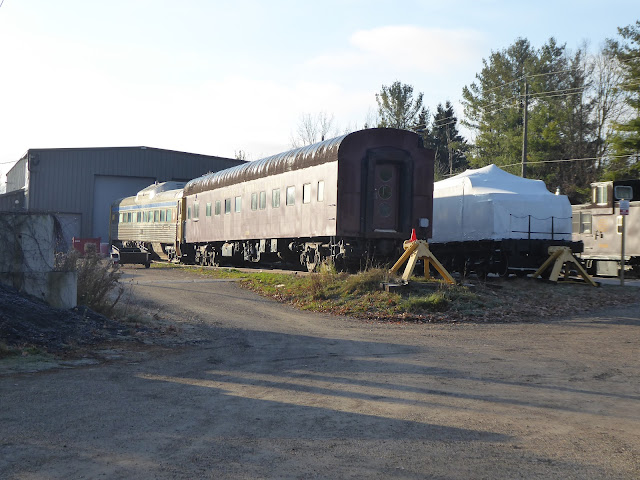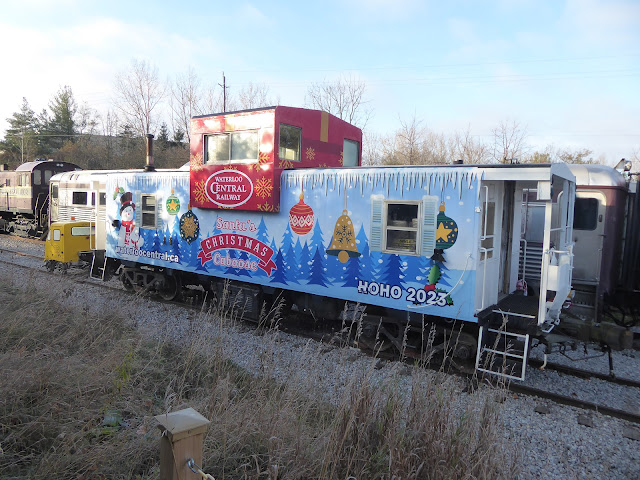As I mentioned in my last post, I had the chance to take some shots of the antique trains that are parked in St. Jacobs, a tourist town just north of Warterloo, Ont. I was in the area last November for a conference where I was giving a mental health presentation. In my first post, I focused my shots on the south end of the rail yard, which is situated behind a residential street, just a few blocks from the main street. Just a short block north on Isabella Street, there is another residential street that dead ends at the tracks. From this publicly available viewing point, you can get some shots of the north end of the yard, where there are a number of pieces of rolling stock near the maintenance facility.
You have to be careful in this spot, because there are private residences and small businesses near the track. To be safe, I stayed on the road and used my camera's zoom, to respect private property.
I also took some shots from the edge of the railway's parking lot, so I could get a shot of this old Budd RDC car, numbered 6135, with a hasty WCRX operating mark stencilled in. The car appears to be used for storage at the moment. The car is still sporting its old Via colours, although I would assume at some point, the railway is going to change its colours to its crimson and grey scheme.
The car, which is an RDC1 unit, was originally built in 1957 for Canadian Pacific and eventually made its way onto the Via Rail roster, where it served its final Via days on the railway's Vancouver Island operations, before that passenger service was shut down due to deteriorating track conditions. This car is not listed on the WCR website, so I'm assuming it's a fairly recent addition. Given its CP origins, a makeover in the maroon and grey scheme would seem fitting.
Before I get to the shots from the north end of the yard, I should add in one final shot I took from the south end. Although WCR is very much a CPR-styled tourist operation, it should be noted that it operates on the old CN Elmira Subdivision and it does roster one unit still in CN paint. In this case, the unit was already decked out in garland and lights for its Christmas runs.
Sadly, every time I visit the WCR yard, this old GMD1 is hiding behind the MLW units. The engine, numbered 1012 (ex-CN 1437), is in the CN olive and yellow paint scheme, which predated the now ubiquitous wet noodle scheme. This railway appears to love heritage schemes. On its website, I noticed that the 1958-built unit was still in its CN safety scheme colours and numbered 1437 when it started pulling for WCR. At some point, it was renumbered and given the heritage CN look. I'd love to get a shot of this unit one day, as I do not have a single GMD1 shot in my collection. So close!
Moving on to the north vantage point, this unlettered six-axle heavyweight sat by itself, basking in the morning sun near to where I was standing. Upon close inspection of the photo, it appears this car was once lettered for WCR but seems to be undergoing some cosmetic work. It's still painted maroon, so I assume at some point it will once again sport some grey and yellow accents of the old Canadian Pacific scheme. I would imagine it will be relettered Waterloo Central Railway at some point. It's hard to track its history, as I couldn't identify it on the railway's website roster.
Toward to maintenance facility, I captured something under a tarp, which was partly shielded from my point of view by an old maroon passenger car. I'm not quite sure what they have under that tarp. I can see some safety rails at the end and some chains, but that's not a lot to go on.
Right beside the tarped-off mystery car, I got a peak at WCRX 79482, a caboose clad in a maroon vintage CPR scheme. Again, the CPR scheme might make you think this is a vintage CPR van, but it's actually one of 548 CN cabooses from the Pointe St-Charles shops in Montreal. This one was built in 1971. The last CN van built in Quebec was in 1977, according to the WCR website. I find it incredible that there were once nearly 600 of these vans plying the rails across CN's system. How times have changed. This caboose came to the tourist railway in 2007 in a red CN scheme. It was returned to its original number and repainted after 2021.
I hope you enjoyed this post, as it really is like strolling through a museum. I still have yet to see this railway in action, at least at a time when I have a camera with me. I did see it in action years ago when I lived in Kitchener-Waterloo, although I wasn't in the habit of taking train photographs at that time.
From its origins as the St. Thomas-based Southwestern Ontario Locomotive Restoration Society to its incarnation as the Waterloo Central, this organization is succeeding in an area where a tourist railway has failed in the past. Its ambitious plans, meticulous attention to detail and determination really do seem like a blueprint for other tourist operations.
Possibly the next time in am in the Waterloo Region, I can figure out a time to actually catch these old antiques in action. That would be a treat.










